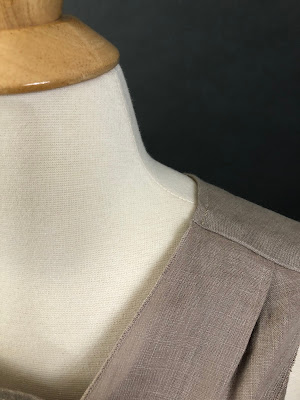As mentioned in my previous post here, I joined the Instagram
sewing challenge #SewJapaneseInJanuary and here is my second finished garment.
This time I used a pattern from a Japanese sewing book called “Shape Shape” by
Natsuno Hiraiwa. If you are interested in reading reviews about this book, check
out the Pattern Review website. This book is written in English and it features 19 sewing patterns for clothes and accessories. What's special about the patterns in the book is they feature designs meant to be worn multiple ways. As stated in the back of the book, "Shape Shape offers everything you need to sew minimally constructed designs with maximum visual impact."
Although I have owned this book for a few years now, this is the first time I have tried a pattern from the book. I made project 1 which is a sleeveless scarf blouse.
This is the modeled photo.
And this is my version.
This nicely shaped blouse features front and back darts, side button closure on one side and attached pleated scarves. The scarves can be draped in a variety of ways allowing for several looks from a single garment. This pattern is so easy to sew and the construction process is straightforward.
Join me in dissecting this project through photos!
It was a bit challenging for me to trace the lines as there were several pattern pieces overlapping and only black ink was used. Some were in gray but it was still challenging. FYI, there were four other projects printed on the above pattern page and they were all overlapping. If you're used to Burda Magazine patterns, then tracing this pattern should be easy peasy for you!
 |
| This top has a very nice graceful silhouette. |
And these are some of the reasons why:
 |
| Front Darts |
 |
| Back Darts |
 |
Buttoned closure on one side
|
The obvious design feature of this top are the attached scarves.
 |
| Here you can see them hanging freely. They are sewn to the shoulder seams, sandwiched between the front and back shoulders. Each scarf measures 26.5" long. |

|
| A close-up of the scarf attachment point. It is pleated. |
 |
The pattern instructions call for a narrow 5/8" hem on the exposed edges of the scarf.
I preferred to finish by using a narrow overlock stitch using the roll hemmer on my Juki serger.
|

*The size chart can be found on page 40 of the book.
*There are only three sizes (Small, Medium, Large). I used size Small based on bust and hips. For good measure I compared the pattern lines with another top pattern that fit me well.
*I deviated a bit from some of the instructions. I skipped the flat fell seam on the shoulders. With my serged seams, I thought it was unnecessary.
*I also did not heed the instruction to do a narrow 5/8" hemming on the scarves. The narrow overlock serged stitches I used was more delicate looking and more polished looking from both sides.
For an outlined review of the pattern used, check out my review at
Pattern Review.
And now a gallery of the different ways to style this lovely top!









































































